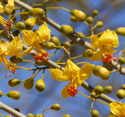Sunday, Apr. 2th, 2008
Vol. 11 No. 6
The Wind
|
|
|
By Michael Plagens |
|
|
PHOENIX, Az. ----- The Olive (Olea europa), which is widely planted in urban areas of the Sonoran Desert, is now loaded with flowers that could easily go unnoticed because they are greenish white and rather small. Their effects, however, are an extreme annoyance to many residents. This is because the olive is an anemophilous plant, that is, its flowers achieve pollination via the wind. Billions of pollen grains are shed into passing breezes by the flowers' stamens. Most of the pollen never comes close to hitting its target, and instead may end up in the eyes and nasal passages of people rather than onto the receptive female parts of other olive flowers. By sheer force of numbers, most, if not all olive flowers will get pollinated. Some municipalities have gone so far as to ban the planting of olive trees, although new pollenless varieties are now available at local nurseries. 
The Blue Palo Verde (Parkinsonia florida) and Palo Brea (Parkinsonia praecox) on the other hand are much more judicious with their pollen grains. Both of these trees, which are also widely cultivated in the Sonoran Desert, instead rely on insects, primarily bees, to affect pollination. These magnificent trees will be producing bountiful bright yellow flowers in the next week or so that Digger Bees and Carpenter Bees find irresistible. Digger Bees find urban habitats difficult because the sandy soil banks where they nest have been dozed away or covered with sopping wet lawns. Carpenter Bees, on the other hand, nest in the crowns of old oleander bushes and even in the wood siding of homes so they are quite common. They are large and frightful looking, but rarely sting. |
Sponsored Links: |
 Previous Issue
Previous Issue |
 Next Issue
Next Issue |
Back to Sonoran Desert Naturalist Home Page
Flora
and Fauna News appears several times
per month and provides current information about the birds, insects and plants
(natural history) living in the Arizona Sonoran Desert.
Copyright Michael J. Plagens, 2008
Send questions or comments to mjplagens@arizonensis.org